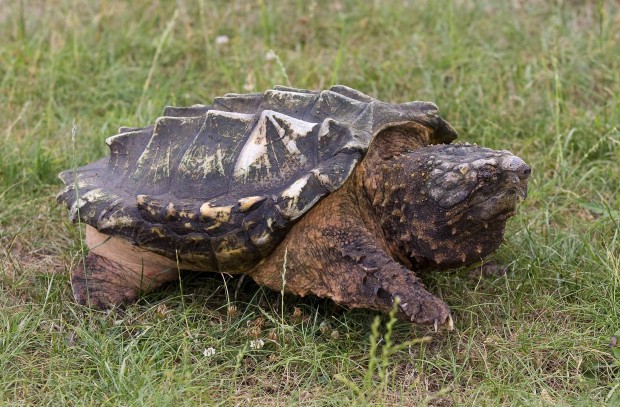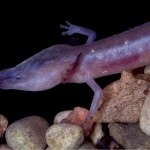Is the Increasingly Rare Alligator Snapping Turtle Next on Endangered List?

Lee Sanders/NTI/Landov
A female Alligator Snapping Turtle at the West Midlands Safari Park in Bewdley, Worcestershire. The Alligator Snapping Turtle is one of the largest freshwater turtles in the world, and was recently found to be not one but three distinct species.
A new study places one of Texas’ strangest—and most imposing—reptiles in a very precarious position.
Published in Zootaxa, the study confirms that the alligator snapping turtle, thought to be just a single species, is actually three genetically distinct species. Alligator snapping turtles, dinosaurian creatures that range throughout river systems in the American Southeast, are the largest freshwater turtles in the world, and the findings put Texas’ already at-risk turtles and their neighboring cousins in further danger.
Though the population split between the three species isn’t equal, simply put, there are now fewer turtles of each species to stand up to pressures from illegal harvesting and habitat loss.
“The major concern moving forward is protecting riverine habitats and wetlands. You can give them all the protection you want against harvest, but if you don’t protect their habitats then it’s not much good,” the paper’s lead author Travis Thomas, a biologist for the Florida Fish and Wildlife Conservation Commission, says.
“Rivers in general are facing an uphill battle. Turtles in general are also facing an uphill battle, especially large turtles. So what does that tell you about a riverine turtle?”
Thomas’ paper looked at morphology, genetics and the fossil record studies of alligator snapping turtles to conclude the existence of the two new species.
“Because those animals in the eastern part of its range are now a separate species, that means that the turtles that are left in Texas are more endangered than we once thought, because now they don’t range all the way from Texas to Florida,” Collette Adkins Giese, senior reptile and amphibian attorney with the Center for Biological Diversity, says.
The Center for Biological Diversity originally petitioned the U.S. Fish & Wildlife Service in July 2012 to protect alligator snapping turtles under the Endangered Species Act, but Adkins Giese says that this new research means there is a stronger case for listing the turtles than ever before.
But, because alligator snapping turtles are already protected under Texas laws, Texas A&M herpetologist Toby Hibbitts believes that the findings will not have much impact on populations in East Texas.
“In terms of the long-term stability of their populations in the state, it seems pretty likely that there hasn’t been much change…in the last 20 years for sure,” Hibbitts said.
Texas classifies alligator snapping turtles as “threatened,” and lists the threats to the species as reservoir construction, illegal or unreported exploitation for domestic and international meat markets, and pollution.
Because they can grow over 220 pounds, alligator snapping turtles were heavily targeted for turtle meat and turtle soup in the 1970s and 1980s. Though commercial harvesting has been outlawed in most states, the turtles are still threatened by the pet trade and recreational harvesting.
The turtles don’t reach sexual maturity until they are between 11 and 13 years old, and reproduce slowly over their century-long lifespans, so any harvest can be particularly detrimental to the species.
“Scientists have shown that there really is no way to sustainably harvest them. Even just removing a couple of individuals can cause a population to crash,” Adkins Giese says.
The U.S. Fish & Wildlife Services is legally bound to issue an initial finding on petitions (an assessment on whether a status review of a species is needed) no more than 90 days after they’re filed, but has yet to make a decision on the original alligator snapping turtle petition.
“We’re confident that we’ll get a positive finding, especially considering that we’ve got such a strong case now, now that there’s three individual species,” Adkins Giese says, “It is a long process … but we’re hoping that with this new research, it gives the agency the nudge it needs to move forward.”
However, Tom McKenzie with the agency’s Southeast Region said the species won’t be considered until 2016 or 2017 at the earliest, if the agency even decides to look at it, because Fish & Wildlife Services is extremely backlogged.
In the meantime, Thomas and his fellow researchers are trying to pinpoint Florida alligator snapping turtle populations. They finished an intensive sampling project of the Suwannee alligator snapping turtle in the fall, and just began sampling the other new species, though he said it is unlikely they will conduct population samples on the species Texas has.
Hibbitts worked on a sampling study of turtles in Texas more than a decade ago, and says that since the animals rarely leave river systems, and stay deeper down in murky water, it is difficult to get an idea of just how many there might be in Texas.
“Even in the sites where we were trapping them all the time — and I worked on a property that had a bunch of them on it — I’ve only ever seen one that wasn’t on the inside of a trap,” Hibbitts said. “You can go your whole life being the average, every-day citizen that doesn’t fish, and you’ll never see one.”

